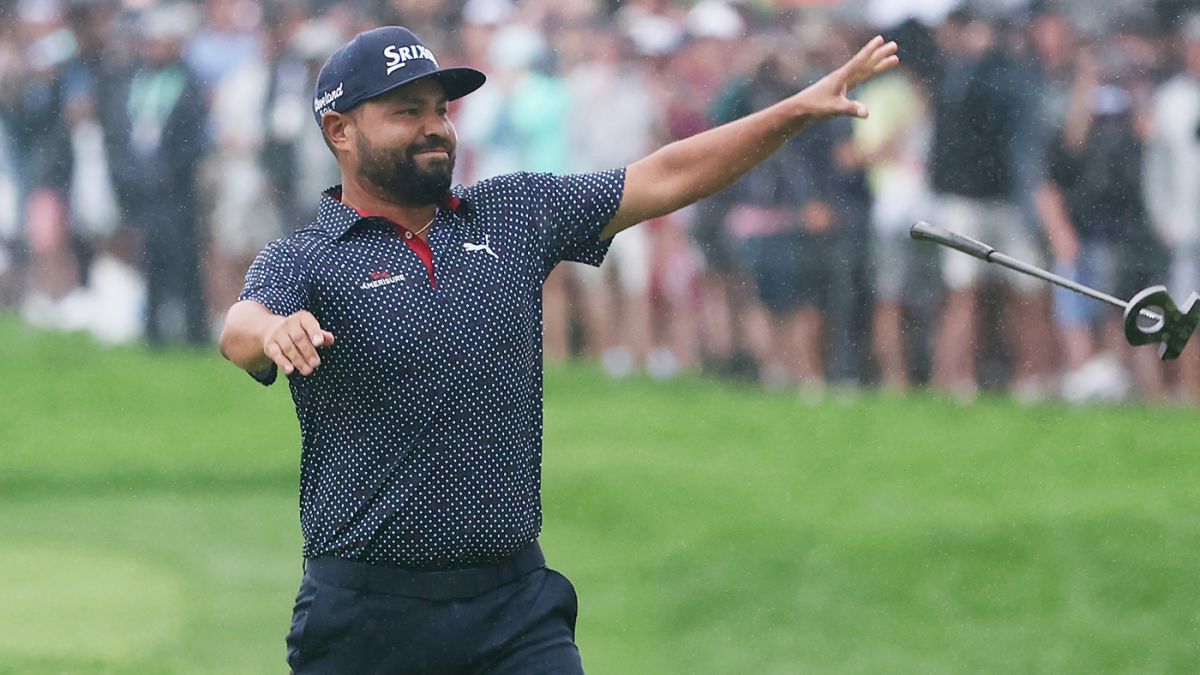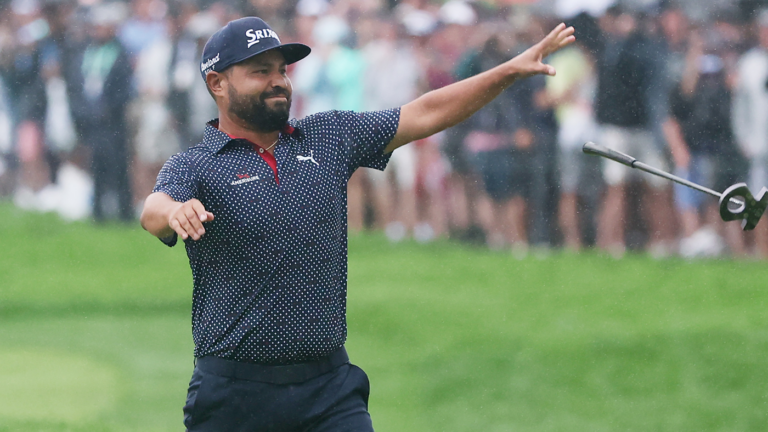
OAKMONT, Pa. — The toughest man in golf won the toughest test in golf. Make no mistake about it, amid a week that was meant for only the big and brawny — the titans of the game — J.J. Spaun proved you need more than just physical gifts and an impressive résumé to be named a U.S. Open champion at Oakmont Country Club.
The 2025 U.S. Open was indeed billed as one strictly for the brutes and the beasts — bombers only, short hitters stay home. With the world’s best entering the third major championship of the season in form, room for an outsider was pushed to the corner in the standing room only section. That’s where Spaun was located, much taller than his 5-foot 9-inch stature suggested.
In what was only his second career U.S. Open start, Spaun started his trek in Western Pennsylvania without any expectations. He was unsure what tests Oakmont would bring and admitted that social media clips of the golf course gave him anxiety before the tournament even began.
And so while Spaun may not have brought the physical tools of a Bryson DeChambeau or Scottie Scheffler — nor the experience of Rory McIlroy or Jon Rahm — he brought something else: toughness hardened by time. Toughness required to conquer a U.S. Open at Oakmont Country Club.
Spaun’s journey was unlike any other in this field, including those who found themselves in contention Sunday in what proved to be one of the stranger final rounds of a major championship in recent memory. (That’s saying something given what transpired in April.)
In what was believed to be a four-man race, Spaun’s name was listed at the bottom of the program. All eyes fell on 44-year-old Adam Scott searching for one (possibly last) chance at glory, a second major championship triumph that would have put an exclamation point on his career. The lovable Viktor Hovland played second fiddle as the best player without a major win; he looked keen on kicking that descriptor from alongside his name.
But this was a U.S. Open, the de facto national championship. To many on site, that mattered. Those fans wanted someone representing the the red, white and blue to raise the U.S. Open trophy, and as Sunday’s final round began, Spaun was not their choice. It was 54-hole leader Sam Burns — Scheffler’s best mate, a five-time PGA Tour winner, a champion at every level of the sport outside majors — who appeared to be the best bet to keep the trophy on American soil.
Sandwiched by two young guns and a 44-year-old heartthrob, Spaun was the forgotten man. The 34-year-old was would not have it any other way.
Not one of those kids who was raised playing junior golf on AJGA or running through academies, Spaun was not groomed for his professional golf career — nor his moment atop the leaderboard at a major championship hosted by the most difficult course in the country.
Spaun just put one foot in front of the other and kept chugging along. He consistently improved, qualified for some bigger tournaments, played well in those events and began to realize his potential. That’s how his professional career progressed; it’s also how his final 18 holes of the U.S. Open unfolded.
Facing his share of adversity as a pro, Spaun was diagnosed with Type-2 diabetes in 2018 after consulting physicians following unexplained weight loss. Three years later, he went in for more tests and found out he was actually Type 1, late onset.
At this point in the 2024 season, Spaun had played 14 events and missed nine cuts with his best finish T26 at the Myrtle Beach Classic. He dropped to 169th in the Official World Golf Rankings. In his eighth season on the PGA Tour, he was on the brink of losing his full-time status if something did not change.
“I just started saying, ‘My career is my career. Whatever happens, happens,” Spaun said. “I’m just happy to have the career I’ve had. That kind of took a lot of pressure off my back as far as expectations on the golf course.
“I was looking like I was going to lose my job, and that was when I had that moment where, ‘If this is how I go out, I might as well go down swinging.’ That’s kind of how my coach tells me about my golf shots or my golf swing on the course. If there’s a challenging shot, he’s like, ‘At least you go down committing to the shot. Don’t bail one out right because you feel uncomfortable; just go down swinging. You might as well put the swing you want on it, and if it doesn’t work out, it doesn’t work out.’ That’s kind of the mantra I’ve been having all year.”
Spaun started his Sunday march in the least ideal way imaginable. A bogey on No. 1 was followed by a brutal break on No. 2 that turned a surefire birdie into his second straight square on the scorecard. Three more 5s came calling — five in a row out of the gate — as Spaun slumped to 3 over for the championship, four strokes off the pace.
It was a horrible way to begin a fourth straight straight day in contention. A lesser man would have shriveled, all that hard work going to waste. Playing 72 holes of major championship golf is difficult. Playing 72 holes of major championship golf while in contention is damn near impossible. It’s about as tough as it gets — sleeping on the first-round lead, waiting all day to get your second round underway, playing in that final group while ping ponging the lead on Saturday before finding yourself with an opportunity to realize your dream one day later.
“As bad as things were going, I just still tried to just commit to every shot. I tried to just continue to dig deep. I’ve been doing it my whole life,” Spaun said. “I think that’s been the biggest difference this year has been being able to do that. Fortunately, I dug very deep on the back nine, and things went my way, and here we are with the trophy.”
Assisted by a 95-minute weather delay, Spaun was granted an opportunity to reset and rediscover his groove.
Before play was suspended, Spaun was 5 over across his first eight holes, all out of sorts and on the fringes of contention. After the restart, he was 3 under in 11 holes and rarely missed a shot.
“I was having lunch with Max Homa at home. We live in the same area. We belong at the same club,” Spaun said. “He was telling a Tiger [Woods] story where he was like, ‘As long as you just like are still there, you don’t have to do anything crazy, especially at a U.S. Open.’ He’s like, ‘Tiger said this would happen, and the wind will switch, but you’ve got to just stay there. Even if you’re four back, you’ve just got to stay there. You don’t have to do anything crazy.’
“I kind of was thinking about that out there this afternoon, where I was four back, maybe going back out after the delay, and then I made some good pars. Nothing crazy, got a really good birdie. Then next thing you know, I’m like tied for the lead within four holes of the restart. That just kind of goes back to that: You just try to like stay there. You don’t have to do anything crazy, especially at a U.S. Open. All those things came true.”
Walking off the 17th green following the drive of his life to set up a birdie to pull him back to even and one clear of Robert MacIntyre, who was in the clubhouse at 1 over. Spaun sauntered back to the 18th tee as the solo leader in the 125th U.S. Open, the same place he stood three days prior.
The grandstands rose and began chanting his name just as a new cloud materialized, bringing back the rain. Spaun put one foot in front of the other and stared dead ahead as chaos engulfed around him. What lied ahead were a perfect drive, a sensible second and a 64-foot, 5-inch birdie putt — a walk-off championship-winner — that will go down in U.S. Open history.
Spaun tossed his putter aside and hugged his caddie, who never lost grip of his umbrella. The U.S. Open champion exited to the side of the green as playing partner Viktor Hovland, who gave Spaun an incredible look at that birdie putt but missed just wide, tapped in for par.
Bending down to catch a breath as tears started to roll uncontrollably from his eyes, Spaun took off his cap to wipe his face clean. A dream realized and a journey complete — a damn tough one at that.
